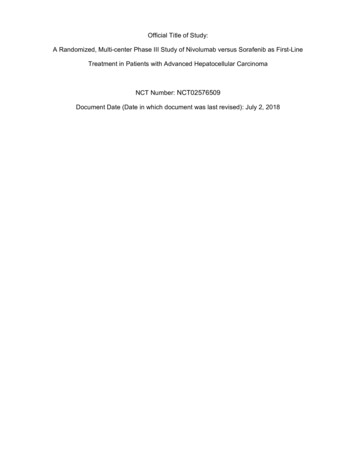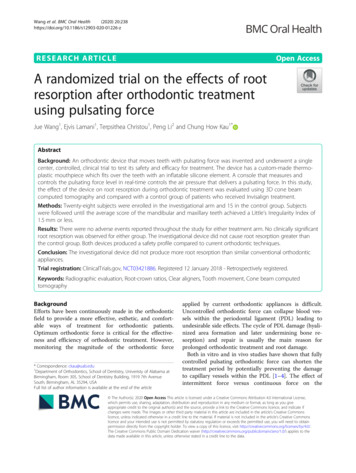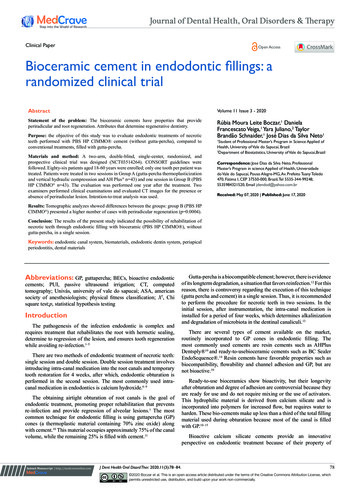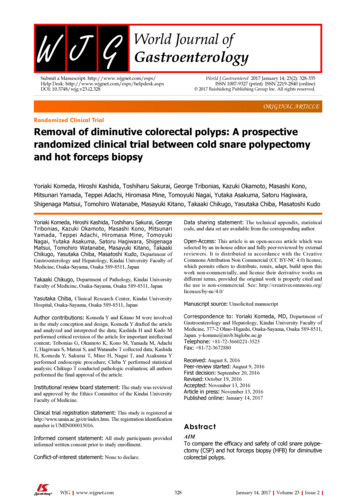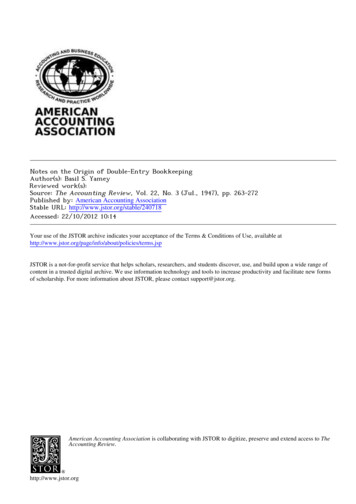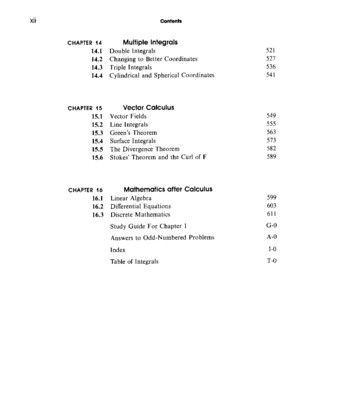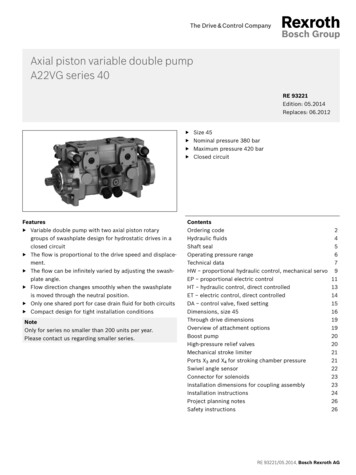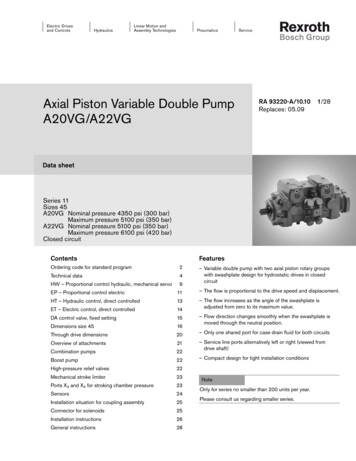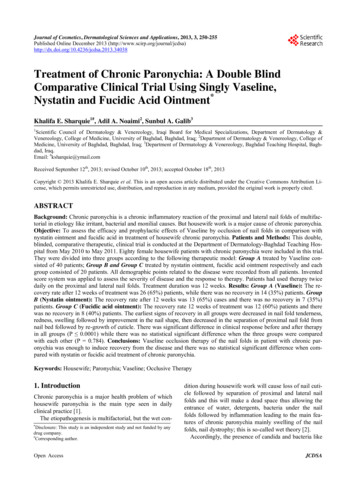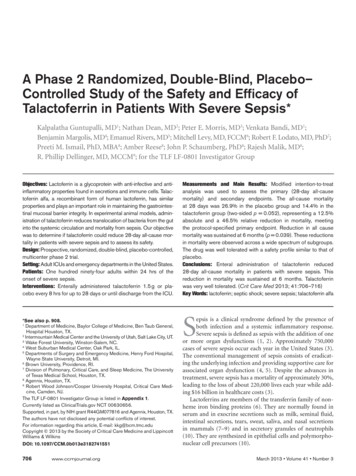
Transcription
A Phase 2 Randomized, Double-Blind, Placebo–Controlled Study of the Safety and Efficacy ofTalactoferrin in Patients With Severe Sepsis*Kalpalatha Guntupalli, MD1; Nathan Dean, MD2; Peter E. Morris, MD3; Venkata Bandi, MD1;Benjamin Margolis, MD4; Emanuel Rivers, MD5; Mitchell Levy, MD, FCCM6; Robert F. Lodato, MD, PhD7;Preeti M. Ismail, PhD, MBA8; Amber Reese8; John P. Schaumberg, PhD8; Rajesh Malik, MD8;R. Phillip Dellinger, MD, MCCM9; for the TLF LF-0801 Investigator GroupObjectives: Lactoferrin is a glycoprotein with anti-infective and antiinflammatory properties found in secretions and immune cells. Talactoferrin alfa, a recombinant form of human lactoferrin, has similarproperties and plays an important role in maintaining the gastrointestinal mucosal barrier integrity. In experimental animal models, administration of talactoferrin reduces translocation of bacteria from the gutinto the systemic circulation and mortality from sepsis. Our objectivewas to determine if talactoferrin could reduce 28-day all-cause mortality in patients with severe sepsis and to assess its safety.Design: Prospective, randomized, double-blind, placebo- controlled,multicenter phase 2 trial.Setting: Adult ICUs and emergency departments in the United States.Patients: One hundred ninety-four adults within 24 hrs of theonset of severe sepsis.Interventions: Enterally administered talactoferrin 1.5 g or placebo every 8 hrs for up to 28 days or until discharge from the ICU.Measurements and Main Results: Modified intention-to-treatanalysis was used to assess the primary (28-day all-causemortality) and secondary endpoints. The all-cause mortalityat 28 days was 26.9% in the placebo group and 14.4% in thetalactoferrin group (two-sided p 0.052), representing a 12.5%absolute and a 46.5% relative reduction in mortality, meetingthe protocol-specified primary endpoint. Reduction in all causemortality was sustained at 6 months (p 0.039). These reductionsin mortality were observed across a wide spectrum of subgroups.The drug was well tolerated with a safety profile similar to that ofplacebo.Conclusions: Enteral administration of talactoferrin reduced28-day all-cause mortality in patients with severe sepsis. Thisreduction in mortality was sustained at 6 months. Talactoferrinwas very well tolerated. (Crit Care Med 2013; 41:706–716)Key Words: lactoferrin; septic shock; severe sepsis; talactoferrin alfa*See also p. 908.1Department of Medicine, Baylor College of Medicine, Ben Taub General,Hospital Houston, TX.2Intermountain Medical Center and the University of Utah, Salt Lake City, UT.3Wake Forest University, Winston-Salem, NC.4West Suburban Medical Center, Oak Park, IL.5Departments of Surgery and Emergency Medicine, Henry Ford Hospital,Wayne State University, Detroit, MI.6Brown University, Providence, RI.7Division of Pulmonary, Critical Care, and Sleep Medicine, The Universityof Texas Medical School, Houston, TX.8Agennix, Houston, TX.9Robert Wood Johnson/Cooper University Hospital, Critical Care Medicine, Camden, NJ.The TLF LF-0801 Investigator Group is listed in Appendix 1.Currently listed as ClinicalTrials.gov NCT 00630656.Supported, in part, by NIH grant R44GM077816 and Agennix, Houston, TX.The authors have not disclosed any potential conflicts of interest.For information regarding this article, E-mail: kkg@bcm.tmc.eduCopyright 2013 by the Society of Critical Care Medicine and LippincottWilliams & WilkinsDOI: 10.1097/CCM.0b013e3182741551epsis is a clinical syndrome defined by the presence ofboth infection and a systemic inflammatory response.Severe sepsis is defined as sepsis with the addition of oneor more organ dysfunctions (1, 2). Approximately 750,000cases of severe sepsis occur each year in the United States (3).The conventional management of sepsis consists of eradicating the underlying infection and providing supportive care forassociated organ dysfunction (4, 5). Despite the advances intreatment, severe sepsis has a mortality of approximately 30%,leading to the loss of about 220,000 lives each year while adding 16 billion in healthcare costs (3).Lactoferrins are members of the transferrin family of nonheme iron binding proteins (6). They are normally found inserum and in exocrine secretions such as milk, seminal fluid,intestinal secretions, tears, sweat, saliva, and nasal secretionsin mammals (7–9) and in secretory granules of neutrophils(10). They are synthesized in epithelial cells and polymorphonuclear cell precursors (10).706www.ccmjournal.orgSMarch 2013 Volume 41 Number 3
Feature Articleare consistent with the demonstratedability of lactoferrin and oral TLF toreduce mortality in bacterial (22, 23)and lipopolysaccharide (Agennix dataon file) models of sepsis, respectively.The safety and efficacy of TLF has alsobeen evaluated in other clinical trials in humans (24–27), enabling thisstudy to explore TLF effects in humansepsis. This phase 2 trial was carriedout to extend the preclinical sepsisresults and to evaluate the safety andefficacy of TLF in severe sepsis inhumans.MATERIALS AND METHODSThis was a double-blind, placebo-controlled study of enteral TLF in patientswith severe sepsis. The protocol wasapproved by the Institutional ReviewBoards of each of the 24 participatingU.S. centers.A total of 194 patients met the eligibility criteria as determined by anindependent clinical coordinating center (Ocean State Clinical CoordinatingCenter, Providence, RI). Patientswere randomized at a ratio of 1:1 toreceive either TLF or placebo for upto 28 days or until discharge from theICU, whichever occurred first. A TLFdose of 4.5 g/day (1.5 g every 8 hrs)was chosen based on extrapolationsFigure 1. Flow diagram for study participants. About one half of the patients were excluded by thefrom the dosage regimens used in aniclinical coordinating center based on inclusion or exclusion criteria. Four patients were subsequentlyexcluded because consent was withdrawn before the first dose of study drug.mal models of sepsis. This dose waswell tolerated in phase 1 studies, andTalactoferrin alfa (TLF) is a recombinant human form ofhigher doses did not result in any apparent increase in activitylactoferrin produced in Aspergillus niger var awamori (11). (e.g., anti-tumor) in prior clinical studies (28, 29). Of the 194Talactoferrin is equivalent to native lactoferrin from humanpatients enrolled, 100 were randomized to TLF and 94 weremilk in 3D structure, molecular weight, biological activity, andrandomized to placebo. A total of 190 were treated, 97 in theother physicochemical properties, differing only in the natureTLF arm and 93 in the placebo arm (Fig. 1). Treatment armsof glycosylation (12). Like the native protein, TLF displays were stratified by study center and by the presence or absenceanti-infective (11, 13–15) and anti-inflammatory (16–18) of cardiovascular (CV) dysfunction (vasopressor-dependentproperties, which have been demonstrated in in vitro and pre- shock) due to sepsis at the time of randomization.clinical studies. Talactoferrin has also been shown to attenuThe study enrolled patients who had a diagnosis of sepsisate indomethacin-induced enteropathy in healthy volunteers, and at least one acute organ dysfunction due to sepsis. Patientssuggesting that it helps maintain the barrier properties ofreceived standard care for severe sepsis, allowing drotrecogingastrointestinal (GI) mucosa (19). In animal models of sepsis, alfa (activated) at the discretion of the primary physician.enterally administered talactoferrin protects against mortal- The first dose of study drug was administered within 4 hrs ofity induced by bacteria (15, 20) and endotoxin administrationrandomization.(Agennix data on file).Safety was monitored daily in the ICU, and a final safetyOral TLF acts locally at the level of the intestinal entero- evaluation was performed 4 wk after the last dose of studycytes and the gut-associated lymphoid tissue (GALT). drug. Patients were contacted at 28 days, 3 months, and 6Talactoferrin has been observed to protect against gut damagemonths postrandomization to determine survival status. Anin both preclinical (21) and clinical studies (19), and to reduceindependent data safety monitoring board (DSMB) evalutranslocation of bacteria across the gut mucosa. These effects ated the safety and efficacy of talactoferrin after enrolling 40Critical Care Medicinewww.ccmjournal.org707
Guntupalli et alpatients followed by two other evaluations prior to study completion. During the early phase of the trial, a disproportionatenumber of patients were being enrolled with severe sepsis froma urinary tract source. Therefore, a decision was made to capenrollment of such patients at 15% (30).ParticipantsThe inclusion criteria were as follows: age 18 yr; onset ofsevere sepsis within the previous 24 hrs; and the ability to takemedication by enteral route (oral or via a feeding tube). Severesepsis was defined as the presence of at least two of the fourcriteria of the systemic inflammatory response syndrome dueto known or suspected infection in association with at leastone of the following sepsis-induced organ dysfunctions: CV(shock), respiratory, renal, hematological, and metabolic (2)(Appendix 2).The exclusion criteria were as follows: severe congestiveheart failure (e.g., New York Heart Association Class IV);known HIV infection with CD4 200 cells/mm3; presence ofthird degree burns involving 20% body surface area; receiving immunosuppressants, to include prednisone 20 mg/dayor equivalent for 2 wk immediately prior to evaluation forenrollment; patient is moribund; severe hypoxic encephalopathy (e.g., postcardiopulmonary resuscitation) or persistentvegetative state; Child-Pugh Class C liver disease; and lack ofcommitment to full, aggressive, life support.Study DrugThe labeled study drug was shipped in cartons containing 1wk’s supply.During the study, the sponsor’s quality control processidentified mislabeled study drug provided by the contractresearch organization responsible for drug labeling. Themislabeling impacted the study drug received by some patients.The study sponsor retrospectively traced exactly whichcarton(s) were administered to each patient and determinedthat the labeling and subsequent randomization errorsoccurred randomly. Because vials of study drug were dispensedin cartons containing 1 wk of drug supply, all patients enrolledin the study received the same study drug for the first weekon study, whether correctly assigned by randomization or dueto a randomization error as a result of mislabeling. The vialmislabeling incident was reported to the study DSMB and theFDA and an independent investigation was performed. TheDSMB reviewed the details of the incident and reanalyzedthe previous DSMB meeting data conservatively so as to notoverestimate the efficacy or safety of TLF. The DSMB notedthat these errors were random, and as such were not associatedwith the introduction of any bias. They concluded that nosafety issues arose from the randomization errors and thatenrollment should continue without modification.StatisticsIn this exploratory study, a sample size of 95 patients per armprovided 80% power to detect a 43% reduction in 28-daymortality (from 30% to 17%) in the talactoferrin arm with708www.ccmjournal.organ a priori selected one-sided p value of 0.1 (two-sided pvalue of 0.2). All data are presented with two-sided p values.The primary analysis consisted of logistical regression withCV dysfunction (vasopressor-dependent shock) included inthe model. The primary efficacy population and the modifiedintention-to-treat population (MITT) included all patientsbased on the treatment they received during the first week.In the MITT population, the 45 patients who received incorrect treatment as a result of the mislabeling were assigned as follows. For the purpose of efficacy, the 23 patients randomized toplacebo or TLF but who received the other study drug only wereincluded in the arm of the study drug they actually received. The22 patients who received a combination of both placebo andTLF (at least one dose of both) during the study were includedin the arm of the study treatment they received during the firstweek. This was done because treatments administered withinthe first week after diagnosis of sepsis are thought to be mostimportant in determining outcome (5, 31, 32). Furthermore,the average duration of study drug administration in the talactoferrin and placebo group was 8.7 and 7.1 days, respectively.Two sensitivity analysis populations and an evaluable population were subsets of the MITT population. Sensitivity analysis 1 was performed by excluding the 22 patients who receivedboth talactoferrin and placebo. Sensitivity analysis 2 was performed by excluding the 45 patients who received the studydrug to which they were not randomized. Those patients in theMITT population who received at least six doses of the studydrug were included in the evaluable patient population. TheITT-as-randomized population included patients as they wererandomized.For safety analysis, data from the 22 patients who receivedat least one dose of TLF and placebo were analyzed as follows.If the patient received TLF first, the patient was included in theTLF group only and all safety data for that patient were includedin the TLF group. If the patient received placebo first, safety datafor that patient were included in the placebo group until thetime the patient received TLF; from that point, all subsequentsafety data for that patient were included in the TLF group.Analyses were conducted to evaluate the effects of the drugover a wide range of baseline characteristics such as the priorlocation of patient, time of first organ dysfunction, sourceof infection, comorbidities, severity of illness by SequentialOrgan Failure Assessment or Acute Physiology and ChronicHealth Evaluation (APACHE) II score, organ failure, race, gender, and age. Secondary endpoints were also analyzed, including the
Talac-toferrin alfa, a recombinant form of human lactoferrin, has similar properties and plays an important role in maintaining the gastrointes- tinal mucosal barrier integrity. In experimental animal models, admin-istration of talactoferrin reduces translocation of bacteria from the gut into the systemic circulation and mortality from sepsis. Our objective was to determine if talactoferrin .
